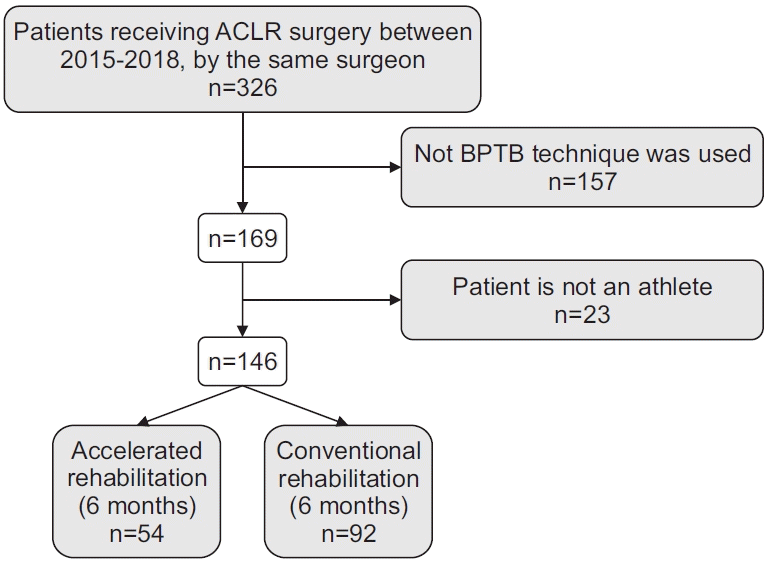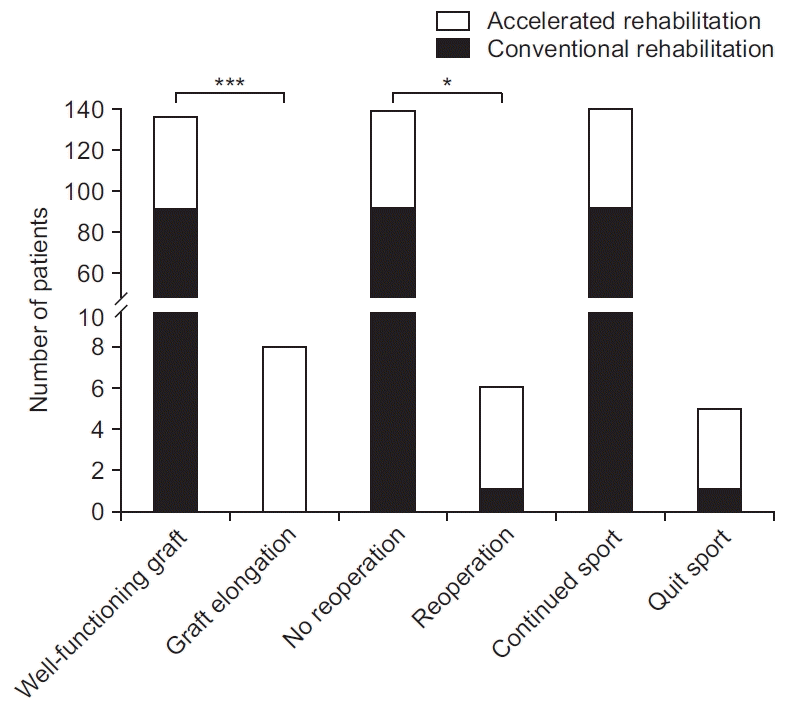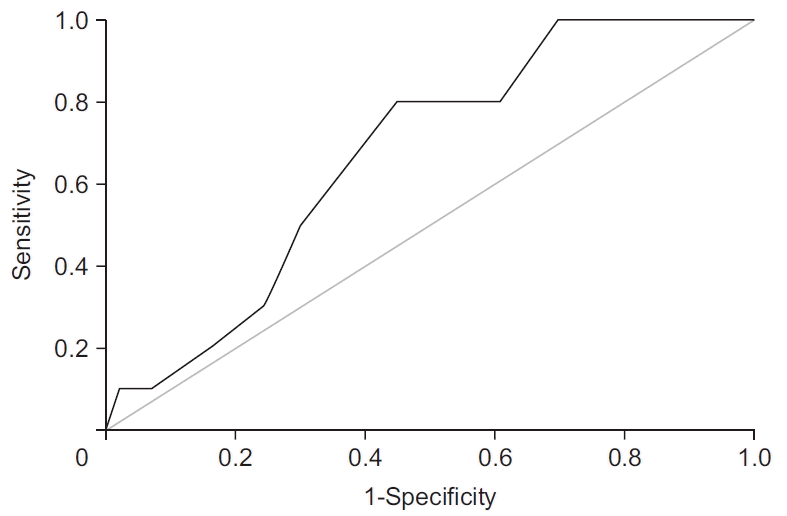Abstract
Objective
Methods
Results
Conclusion
Notes
Conceptualization: Török L, Hartmann P, Jávor P. Formal analysis: Rárosi F. Funding Acquisition: Hartmann P, Jávor P. Project administration: Hartmann P. Visualization: Török K. Writing–original draft: Jávor P. Writing–review and editing: Török L, Hartmann P, Török K. Approval of the final manuscript: all authors.
ACKNOWLEDGMENTS
REFERENCES
Fig. 1.

Fig. 2.

Fig. 3.

Table 1.
| All patients (n=146) | Accelerated rehabilitation group (n=54) | Conventional rehabilitation group (n=92) | p-value | |
|---|---|---|---|---|
| Age (yr) | 26±6 | 24±3 | 28±7 | <0.001*** |
| Median (IQR) | 25 (23–28) | 24 (22–26) | 25 (23–30) | |
| Sex | 0.241 | |||
| Female | 29 (19.9) | 8 (14.8) | 21 (22.8) | |
| Male | 117 (80.1) | 46 (85.2) | 71 (77.2) | |
| Practiced sport | 0.752 | |||
| Soccer | 106 (72.6) | 39 (72.2) | 67 (72.8) | |
| Handball | 19 (13.0) | 7 (13.0) | 12 (13.0) | |
| Basketball | 6 (4.1) | 3 (5.6) | 3 (3.3) | |
| Volleyball | 2 (1.4) | 1 (1.9) | 1 (1.1) | |
| Tennis | 3 (2.1) | 0 (0) | 3 (3.3) | |
| Athletics | 1 (0.7) | 1 (1.9) | 0 (0) | |
| Skiing | 2 (1.4) | 0 (0) | 2 (2.2) | |
| Judo | 4 (2.7) | 2 (3.7) | 2 (2.2) | |
| Wrestling | 2 (1.4) | 1 (1.9) | 1 (1.1) | |
| Other martial arts | 1 (0.7) | 0 (0) | 1 (1.1) | |
| Joint mobility (Beighton score) | 0.710 | |||
| <4 | 138 (94.5) | 52 (96.3) | 86 (93.5) | |
| 4 | 8 (5.5) | 2 (3.7) | 6 (6.5) | |
| ≥5 | 0 (0) | 0 (0) | 0 (0) | |
| Comorbidities | ||||
| BMI >25 kg/m2 | 6 (4.1) | 0 (0) | 6 (6.5) | 0.085 |
| Chronic disease | 11 (7.5) | 3 (5.6) | 8 (8.7) | 0.747 |
| Hypertension | 8 (5.5) | 3 (5.6) | 5 (5.4) | 0.975 |
| Diabetes | 2 (1.4) | 0 (0) | 2 (2.2) | 1 |
| Hypothyroidism | 1 (0.7) | 0 (0) | 1 (1.1) | 1 |
| Gout | 1 (0.7) | 0 (0) | 1 (1.1) | 1 |
| Concomitant injuries | ||||
| Meniscus lesion | 41 (28.1) | 12 (22.2) | 29 (31.5) | 0.228 |
| MCL injury | 13 (8.9) | 4 (7.4) | 9 (9.8) | 0.768 |
Values are presented as mean±standard deviation or number (%).
The patient population consisted mainly of young healthy athletes. Most study participants (72.6%) were soccer players. Meniscus lesions and MCL injuries were diagnosed using magnetic resonance imaging. Incomplete superficial fissures were not considered meniscus injuries because of the lack of a notable influence on the long-term outcome.
Beighton scoring was performed and interpreted with a cut-off point of ≥5/9 for generalized joint laxity.
IQR, interquartile range; BMI, body mass index; MCL, medial collateral ligament.
Table 2.
| All patients (n=146) | Accelerated rehabilitation group (n=54) | Conventional rehabilitation group (n=92) | p-value | ||
|---|---|---|---|---|---|
| Postoperative complications | |||||
| Early complications | 7 (4.8) | 3 (5.6) | 4 (4.3) | ||
| Hemarthrosis | 6 (4.1) | 3 (5.6) | 3 (3.3) | 0.670 | |
| Septic arthritis | 1 (0.7) | 0 (0) | 1 (1.1) | 1 | |
| Chronic complications | 11 (7.5) | 8 (14.8) | 3 (3.3) | 0.019* | |
| Cyclops syndrome | 3 (2.1) | 0 (0) | 3 (3.3) | 0.296 | |
| Graft elongation | 8 (5.5) | 8 (14.8) | 0 (0) | <0.001*** | |
| Injuries during rehabilitation | 5 (3.4) | 3 (5.6) | 2 (2.2) | 0.367 | |
| Meniscus lesion | 3 (2.1) | 2 (3.7) | 1 (1.1) | 0.556 | |
| Graft rupture | 2 (1.4) | 1 (1.9) | 1 (1.1) | 1.000 | |
| Sagittal knee laxitya) (mm) | |||||
| 6 weeks after surgery | |||||
| <3 | 134 (91.8) | 49 (90.7) | 85 (92.4) | 0.726 | |
| ≥3 and <6 | 12 (8.2) | 5 (9.3) | 7 (7.6) | ||
| ≥6 | 0 (0) | 0 (0) | 0 (0) | ||
| 3 months after surgery | |||||
| <3 | 140 (95.9) | 52 (96.3) | 88 (95.7) | 1.000 | |
| ≥3 and <6 | 6 (4.1) | 2 (3.7) | 4 (4.3) | ||
| ≥6 | 0 (0) | 0 (0) | 0 (0) | ||
| 6 months after surgery | |||||
| <3 | 136 (93.2) | 52 (96.3) | 84 (91.3) | 0.485 | |
| ≥3 and <6 | 9 (6.2) | 2 (3.7) | 7 (7.6) | ||
| ≥6 | 1 (0.7) | 0 (0) | 1 (1.1) | ||
| 12 months after surgery | |||||
| <3 | 127 (87.0) | 42 (77.8) | 85 (92.4) | 0.001*** | |
| ≥3 and <6 | 10 (6.8) | 3 (5.6) | 7 (7.6) | ||
| ≥6 | 9 (6.2) | 9 (16.7) | 0 (0) | ||
| Outcomes | |||||
| Graft failure | 10 (6.8) | 9 (16.6) | 1 (1.1) | <0.001*** | |
| Reoperation due to graft failure | 6 (4.1) | 5 (9.3) | 1 (1.1) | 0.0261* | |
| Quit competitive sport | 5 (3.4) | 4 (7.4) | 1 (1.1) | 0.0625 | |
Values are presented as number (%).
Graft elongation was observed only in the accelerated rehabilitation group. Meniscus lesions, graft elongation, graft rupture, and cyclops syndrome were diagnosed using magnetic resonance imaging. In case of elongated grafts, technical failures, such as tunnel malposition could not be revealed. Incomplete superficial fissures were not considered meniscus injuries because of the lack of a notable influence on the long-term outcome. Patients were enrolled 24 months after anterior cruciate ligament reconstruction surgery to determine whether they could compete in their sports at the same level as before their anterior cruciate ligament injury.




 PDF
PDF Citation
Citation Print
Print



 XML Download
XML Download